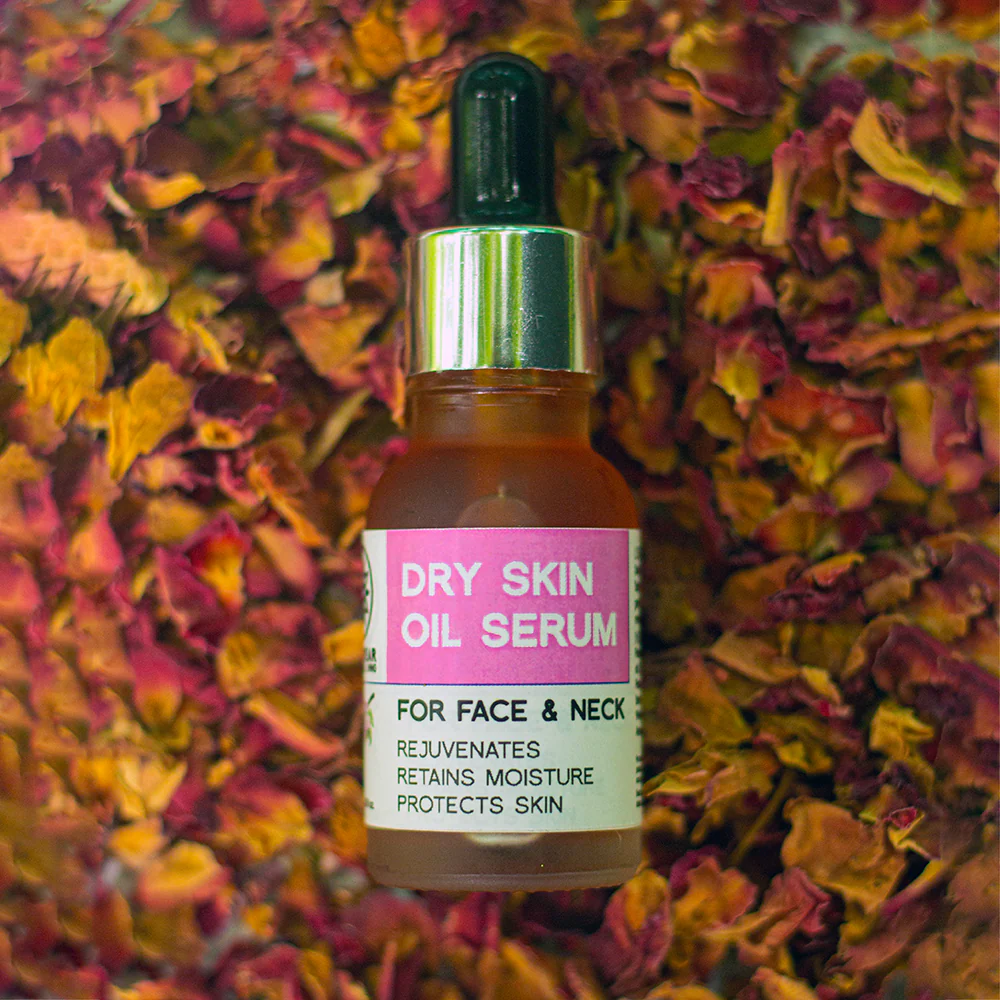Dry Skin Serum – for Face & Neck (15ml)
Original price was: ₹499.0.₹449.0Current price is: ₹449.0.
Some key benefits include:
- Keeping moisture locked into the skin.
- Enhancing the glow of your skin.
- Improving dullness and spots.
- Clearing up congested skin.
- Description
- Additional information
- Reviews (0)
- Q & A
- Sustainability Remark
- More Offers
- Store Policies
- Inquiries
TreeWear’s Dry Skin Serum is the perfect blend of oils to keep your Face & Neck rejuvenated and free from excessively dry skin. The lighter Ashwagandha oil ensures that the oils are deeply absorbed into the skin.
Orange, Patchouli, Vetiver, and Apricot oils enrich and uplift the skin, providing a youthful glow around the face & neck.
Some key benefits include:
- Keeping moisture locked into the skin.
- Enhancing the glow of your skin.
- Improving dullness and spots.
- Clearing up congested skin.
USAGE
The Dry Skin Serum for the face and neck can be used daily. After bathing or washing your face, apply a few drops (5-10) of the Serum and massage the oil lightly around your face and neck. For external use only. Please patch test the product on your wrist/forearm before use.
INGREDIENTS
Rosewood oil, Patchouli oil, Orange oil, Palmarosa oil, Vetiver oil blended with Apricot oil, Wheat germ oil, and Ashwagandha carrier oil.
| Weight | 0.015 kg |
|---|
You must be logged in to post a review.
Q & A
- Ingredients: Sustainable dry skin serums often use natural, organic, and ethically sourced ingredients. These ingredients are cultivated with minimal environmental impact, avoiding harmful pesticides and fertilizers. Sustainable farming practices promote soil health, biodiversity, and water conservation.
- Packaging: Sustainable serums typically come in eco-friendly packaging, such as recyclable, biodegradable, or refillable containers. Reducing plastic use and incorporating recycled materials lowers the environmental impact.
- Manufacturing Processes: Environmentally conscious brands adopt sustainable manufacturing practices, such as using renewable energy sources (solar, wind) and minimizing waste. Efficient production methods reduce energy consumption and carbon emissions.
- Supply Chain: Sustainable products often have a transparent and ethical supply chain. This includes fair trade practices, reducing transportation emissions by sourcing locally, and ensuring ethical labor practices.
Carbon Footprint of Dry Skin Serum
The carbon footprint of a dry skin serum is considered low due to the following reasons:- Natural Ingredients: Using plant-based ingredients generally results in lower carbon emissions compared to synthetic ones. For example, plant cultivation can sequester carbon dioxide, whereas synthesizing chemicals often involves energy-intensive processes.
- Minimal Processing: Natural ingredients usually require less processing, reducing energy consumption and emissions associated with manufacturing.
- Eco-Friendly Packaging: Packaging made from recycled materials or designed to be recyclable reduces the environmental impact. Glass, aluminum, and biodegradable plastics often have lower carbon footprints compared to conventional plastics.
- Efficient Distribution: Brands that focus on local sourcing and distribution minimize transportation emissions. This is significant because transportation (especially air freight) is a major contributor to carbon emissions.
- Sustainable Practices: Companies committed to sustainability often implement practices such as carbon offsetting, renewable energy use, and waste reduction programs, all of which contribute to a lower carbon footprint.
Scientific Explanation and References
- Natural Ingredients: Studies have shown that the cultivation of organic ingredients reduces greenhouse gas emissions and promotes soil carbon sequestration .
- Packaging: Life cycle assessments of packaging materials indicate that recycled and biodegradable materials have a significantly lower environmental impact compared to conventional plastics .
- Manufacturing Processes: Renewable energy use in manufacturing can reduce greenhouse gas emissions by up to 80% compared to fossil fuel-based energy sources .
- Supply Chain Efficiency: Research indicates that local sourcing and shorter supply chains reduce transportation-related emissions .
References
- Soil Carbon Sequestration and Organic Farming:
- "Organic farming and climate change mitigation" by Smith et al. (2020)
- Greenhouse Gas Emissions from Agricultural Practices:
- "Agriculture, Forestry and Other Land Use (AFOLU)" - IPCC Report
- Life Cycle Assessment of Packaging Materials:
- "Comparative life cycle assessment of packaging systems for food" by Notarnicola et al. (2017)
- Renewable Energy in Manufacturing:
- "The environmental benefits of renewable energy" by the International Energy Agency (IEA)
- Supply Chain Emissions:
- "Supply Chain Optimization and its Impact on Sustainability" by Chopra and Meindl (2019)
General Inquiries
There are no inquiries yet.



















Reviews
There are no reviews yet.